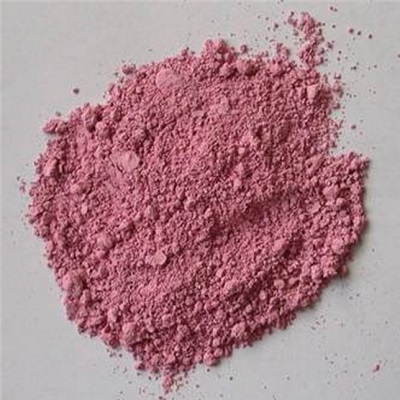|
| | Cobalt(II) hydroxide Chemical Properties |
| Melting point | °Cd ec.) | | density | 3.597 g/mL at 25 °C(lit.) | | vapor pressure | 0Pa at 20℃ | | storage temp. | Inert atmosphere,Room Temperature | | form | Powder | | Specific Gravity | 3.597 | | color | Pink to purple | | PH | 9.15(1 mM solution);9.15(10 mM solution);9.15(100 mM solution) | | Water Solubility | Soluble in acids and ammonia. Very slightly soluble in water. Insoluble in dilute alkalis. | | Sensitive | Air Sensitive | | Merck | 14,2442 | | Solubility Product Constant (Ksp) | pKsp: 14.23 | | Exposure limits | ACGIH: TWA 0.02 mg/m3 | | Stability: | Stability | | CAS DataBase Reference | 21041-93-0(CAS DataBase Reference) | | EPA Substance Registry System | Cobalt hydroxide (Co(OH)2) (21041-93-0) |
| | Cobalt(II) hydroxide Usage And Synthesis |
| Physical Properties | Two forms occur, a rose-red powder (more stable) and a bluish-green powder less stable than the red form; rhombohedral crystals; density 3.597 g/cm3; decomposes on heating; practically insoluble in water 3.2 mg/L; Ksp 1.0x10–15; soluble in acids and ammonia; insoluble in dilute alkalis.

The addition of alkali metal hydroxides to solutions of cobalt(II) salts results in the precipitation of cobalt(II) hydroxide in either a blue or pink form depending upon the conditions. The pink form is the more stable of the two and is obtained when a suspension of the blue form is allowed to stand or is warmed. Cobalt(II) hydroxide is amphoteric, dissolving in alkalis to form blue solutions of the [Co(OH)4]2~ ions. In the presence of alkali, suspensions of Co(OH)8 are oxidized by air to the brown CoO(OH), this oxidation being brought about rapidly by oxidants such as hypochlorite, bromine water or hydrogen peroxide. The pink Co(OH)2 (density 3.597) has the brucite (Mg(OH)2) structure in which the cobalt atoms are surrounded by six hydroxides. The blue form is more disordered, but its structure is not known for certain. | | Uses | Cobalt(II) hydroxide is used as a drier for paints and varnishes and is added to lithographic printing inks to enhance their drying properties. Other applications are in the preparation of cobalt salts; as a catalyst; and in storage battery electrodes.
| | Preparation | Cobalt(II) hydroxide is obtained as a precipitate when an alkaline hydroxide is added to an aqueous solution of cobalt(II) salt:
CoCl2 + 2NaOH → Co(OH)2 + 2NaCl
Co(NO3)2 + 2NaOH → Co(OH)2 + 2NaNO3
| | Reactions | Thermal decomposition to cobaltous oxide, CoO, occurs at 168°C in a vacuum.
Cobalt(II) hydroxide is oxidized by air and other oxidizing agents, forming cobalt(III) hydroxide, Co(OH)3. Reactions with mineral acids produce corresponding Co2+ salts.
| | Description | The addition of alkali metal hydroxides to solutions of cobalt(II) salts results in the precipitation of cobalt(II) hydroxide in either a blue or pink form depending upon the conditions. The pink form is the more stable of the two and is obtained when a suspension of the blue form is allowed to stand or is warmed. Cobalt(II) hydroxide is amphoteric, dissolving in alkalis to form blue solutions of the [Co(OH)4]2- ions. In the presence of alkali, suspensions of Co(OH) are oxidized by air to the brown CoO(OH), this oxidation being brought about rapidly by oxidants such as hypochlorite, bromine water or hydrogen peroxide. The pink Co(OH)2 (density 3.597) has the brucite (Mg(OH)2) structure in which the cobalt atoms are surrounded by six hydroxides. The blue form is more disordered, but its structure is not known for certain. | | Chemical Properties | Rose-red powder.Soluble in
acids and ammonium salt solutions; insoluble in
water and alkalies. | | Uses | Cobalt salts, paint and varnish driers, catalyst,
storage-battery electrodes. | | Uses | Cobalt(II) hydroxide is used as a drying agent for paints and varnishes. It acts as an aid to dry the lithographic inks and catalyst in the preparation of battery electrode impregnating solutions. It is also involved in the synthesis of other cobalt compounds. | | Flammability and Explosibility | Notclassified |
| | Cobalt(II) hydroxide Preparation Products And Raw materials |
|



